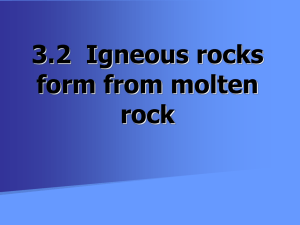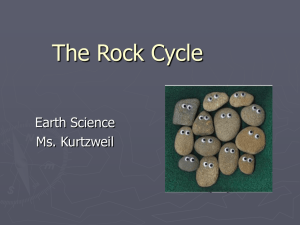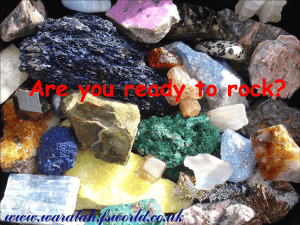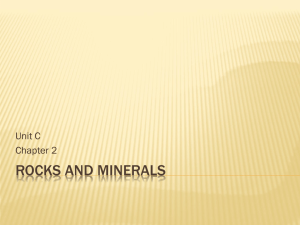Regents Unit 3.RocksandMinerals.Review Topics
advertisement
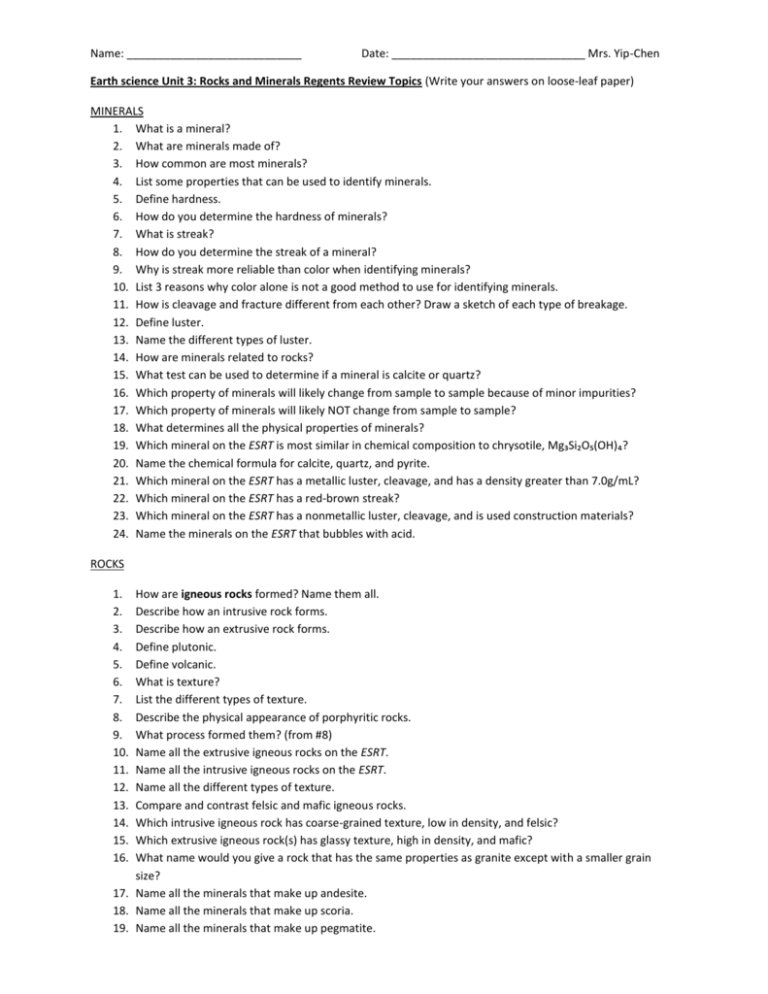
Name: ____________________________ Date: _______________________________ Mrs. Yip-Chen Earth science Unit 3: Rocks and Minerals Regents Review Topics (Write your answers on loose-leaf paper) MINERALS 1. What is a mineral? 2. What are minerals made of? 3. How common are most minerals? 4. List some properties that can be used to identify minerals. 5. Define hardness. 6. How do you determine the hardness of minerals? 7. What is streak? 8. How do you determine the streak of a mineral? 9. Why is streak more reliable than color when identifying minerals? 10. List 3 reasons why color alone is not a good method to use for identifying minerals. 11. How is cleavage and fracture different from each other? Draw a sketch of each type of breakage. 12. Define luster. 13. Name the different types of luster. 14. How are minerals related to rocks? 15. What test can be used to determine if a mineral is calcite or quartz? 16. Which property of minerals will likely change from sample to sample because of minor impurities? 17. Which property of minerals will likely NOT change from sample to sample? 18. What determines all the physical properties of minerals? 19. Which mineral on the ESRT is most similar in chemical composition to chrysotile, Mg₃Si₂O₅(OH)₄? 20. Name the chemical formula for calcite, quartz, and pyrite. 21. Which mineral on the ESRT has a metallic luster, cleavage, and has a density greater than 7.0g/mL? 22. Which mineral on the ESRT has a red-brown streak? 23. Which mineral on the ESRT has a nonmetallic luster, cleavage, and is used construction materials? 24. Name the minerals on the ESRT that bubbles with acid. ROCKS 1. 2. 3. 4. 5. 6. 7. 8. 9. 10. 11. 12. 13. 14. 15. 16. How are igneous rocks formed? Name them all. Describe how an intrusive rock forms. Describe how an extrusive rock forms. Define plutonic. Define volcanic. What is texture? List the different types of texture. Describe the physical appearance of porphyritic rocks. What process formed them? (from #8) Name all the extrusive igneous rocks on the ESRT. Name all the intrusive igneous rocks on the ESRT. Name all the different types of texture. Compare and contrast felsic and mafic igneous rocks. Which intrusive igneous rock has coarse-grained texture, low in density, and felsic? Which extrusive igneous rock(s) has glassy texture, high in density, and mafic? What name would you give a rock that has the same properties as granite except with a smaller grain size? 17. Name all the minerals that make up andesite. 18. Name all the minerals that make up scoria. 19. Name all the minerals that make up pegmatite. 20. What is the color, density, and composition of diorite? 21. How is vesicular basalt and basalt different from each other? 22. Why is obsidian on the left- hand side of the “Scheme for Igneous Rock Identification” when it is a darkcolored rock? 23. What is the crystal size of rocks with glassy, fine, coarse, and very coarse grain? 24. Approximately how much percent of olivine is in dunite? 25. Approximately how much percent of biotite is in rhyolite? 26. Which processes form clastic sedimentary rocks? Name these rocks. 27. Which processes form chemical sedimentary rocks? Name these rocks. 28. Which processes form bioclastic sedimentary rocks? Name these rocks. 29. How does the grain size from shale to conglomerate change – increases or decreases? 30. What is the difference between breccia and conglomerate? 31. What is the grain size of siltstone? 32. What is the composition of all clastic (fragmental) sedimentary rocks? 33. What is shale made of? 34. How is sandstone different from siltstone? 35. Which one(s) of the clastic sedimentary rocks have the largest range of sediment size? 36. How are rock salt, rock gypsum, and dolostone different from each other? 37. What are the 2 ways that form limestone? 38. What is the composition and grain size of limestone? 39. How does bituminous coal form? 40. What is the composition of bituminous coal? 41. How are metamorphic rocks formed? Name these rocks. 42. Define foliation. 43. How are metamorphic rocks classified by? Name the rocks in each of the 2 groups. 44. Name and define the 2 types of metamorphism. 45. Which foliated metamorphic rock is composed of only mica minerals? 46. Which foliated metamorphic rock(s) is (are) composed of all the listed minerals? 47. Which rock is slate metamorphosed from? 48. Describe the texture of gneiss. 49. What sequence of change in rock type occurs as shale is subjected to increasing heat and pressure? 50. Which rock is anthracite coal metamorphosed from? 51. Which rock is quartzite metamorphosed from? 52. What is the composition of quartzite? 53. Which rock(s) is(are) marble metamorphosed from? 54. Name the metamorphic rocks that were formed from contact metamorphism. 55. Describe how you can distinguish a sedimentary, igneous, and metamorphic rock apart from each other. 56. What material is created directly from the processes of weathering and erosion? 57. Name the four processes that form sedimentary rocks from sediments. 58. Which process do all rocks undergo in order to be changed back into magma? 59. Which stream velocity would carry the greatest size of sediments? 60. If a stream decreases in velocity from 100cm/s to 5cm/s, which sediment size will it not be able to carry? 61. What is the grain size range that classifies sediments as sand? Boulders? Be able to: 1. 2. 3. 4. Find Average Chemical Composition of Earth’s Crust, Hydrosphere, and Troposphere - ESRT p.1 Generalized landscape regions of NYS - ESRT p.2 Generalized bedrock geology of NYS- ESRT p.3 Interpret all the charts on Rocks and Minerals (including Relationship of Transported Particle Size to Water Velocity) - ESRT p.6-7 and 11.



